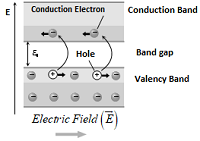Conductivity of Semiconductor
Semiconductors are the materials which have conductivity between conductors and non-conductors or insulators. In semiconductors, the conduction band electron and valence band hole participate in electrical conduction. Semiconductors can be compounds such as gallium arsenide or pure elements, such as germanium or silicon.
1) In intrinsic semiconductors ne = nh, both electron and holes contribute in current conduction.
2) When some potential difference is applied across a piece of intrinsic semiconductor current flows in it due to both electron and holes i.e. i = ie + ih ⇒ i = eA (neve + nhvh).

3) As we know that, \(\sigma =\frac{J}{E}=\frac{i}{AE}\). Hence, conductivity of semiconductor: σ = e (neμe + nhμh), where ve = Drift velocity of electron, vh = Drift velocity of holes, E = Applied electric field, \({{\mu }_{e}}=\frac{{{v}_{e}}}{E}=\) Mobility of electron and \({{\mu }_{h}}=\frac{{{v}_{h}}}{E}=\) Mobility of holes.
4) Motion of electrons in the conduction band and of holes the valence band under the actions of electric field is shown below.

5) At absolute zero temperature (0K) conduction band of semiconductor is completely empty i.e. σ = 0. Hence, the semiconductor behaves as an insulator.
